by R. John Howe
- Part 2 -
Next let’s talk
about the historical use of red in rugs and other textiles.

Barber has also published on some mummies found in far northwest China estimated to be from about 1,000 BC.
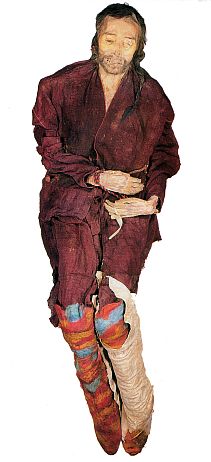
This mummy is over six feet tall, has brown hair, looks Caucasian and was labeled by the press, “Cherchen Man,” a reference to the name of a town near where the mummies were found.
Here is one observer’s description:
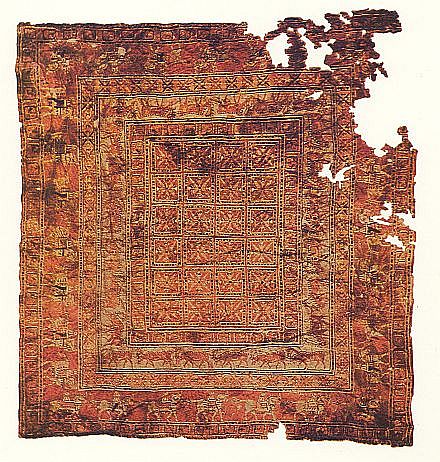
The Pazaryk rug, carbon dated to 500 BC has a complex, sophisticated design and a fairly wide array of colors, suggesting the product of a long tradition. The predominant one is its red ground.
About the time the Pazyryk carpet was woven, the ancient Greeks were
also weaving.
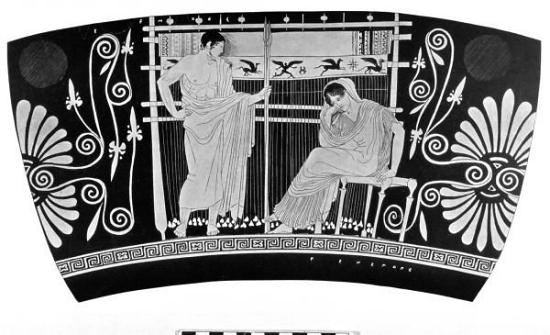
Few, if any textiles survive from the Greek classical period. Literary accounts, as well as scenes from painted vases, make it clear that the ancient Greeks both wove textiles and made clothing. The principal material they worked with was wool, but linen from flax was also common.
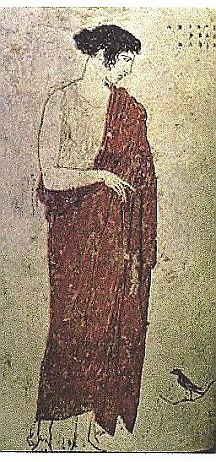
Greek textiles were often dyed, the most desirable dye being a reddish
purple color derived from aquatic murex
snails.
In this same era we also have an example from South America.
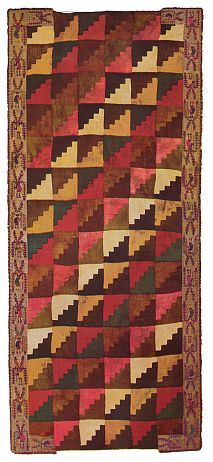
This is described as an “Early Horizon” mantle estimated to have been woven 700-500 BC. The “Early Horizon” reference is to an early period of Andean cultural development.
A little closer look at a detail of it.
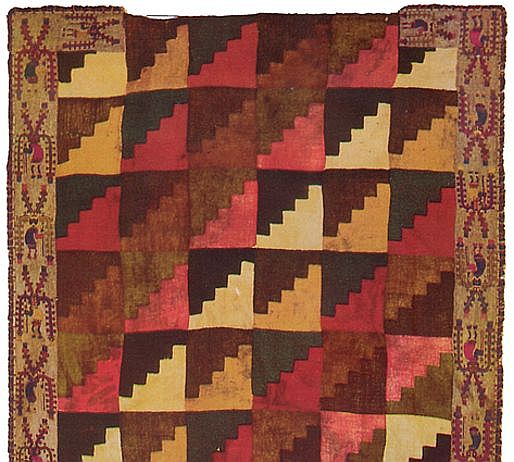
And about 500 years later, weavers in northwest China produced this skirt that is in a collection in Switzerland.
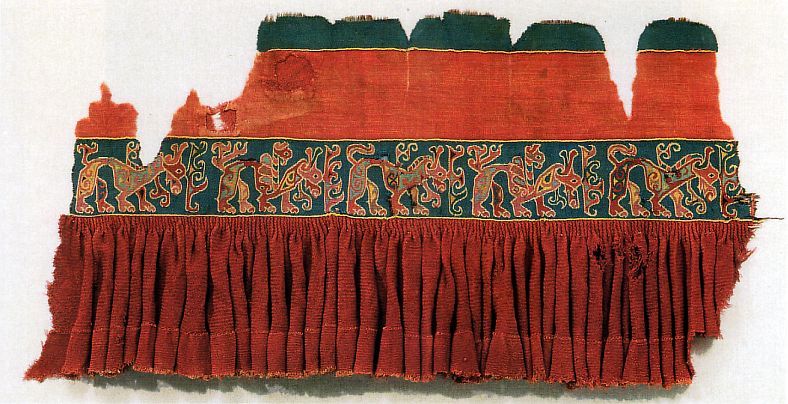
This fragment has been C-14 dated 123BC - 124AD and analyses of the dyes reveal that all of the red tones come from Indian madder, including the pink and the patch.
Some Roman textiles have survived, but, at least, until recently, most of the known Roman examples were from Egypt. Here is one small grouping.
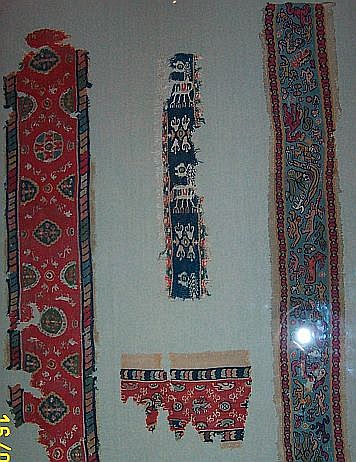
“Roman” Egypt was followed in about 4 AD by “Coptic” Egypt for which we have quite a few surviving textiles.
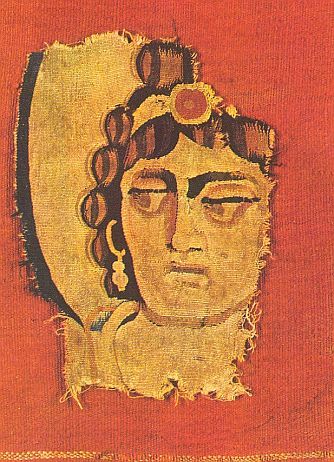
And although there were rugs and textiles made all over the world during the next 900 or so years, until the 13th century, most of the currently known surviving examples (this may be changing) are from the Mediterranean area. Here are a few examples quickly just to let you see that red was not neglected during this relative hiatus in the historical textile record.
Here is another piece from pre-Columbian America. It is a Huari headband, about 600-800 AD.
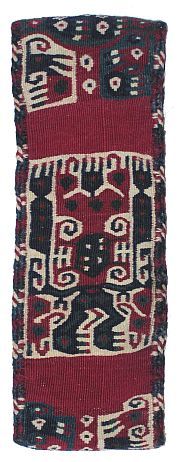
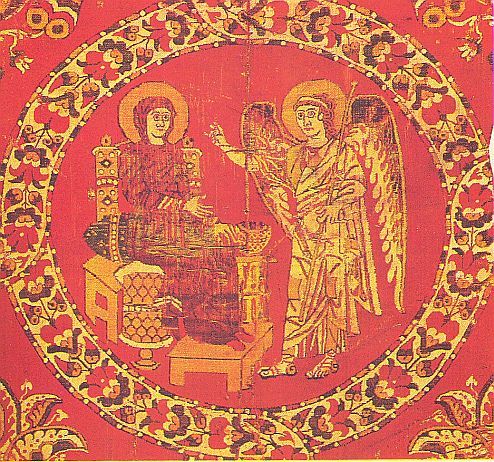
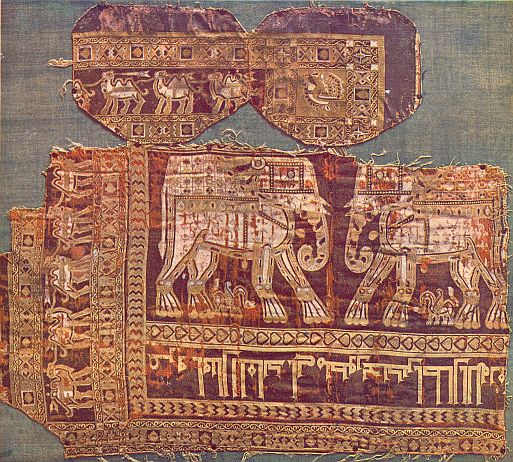
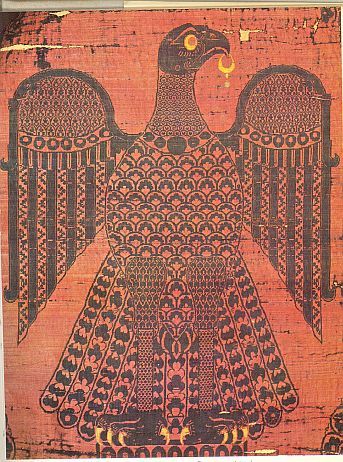
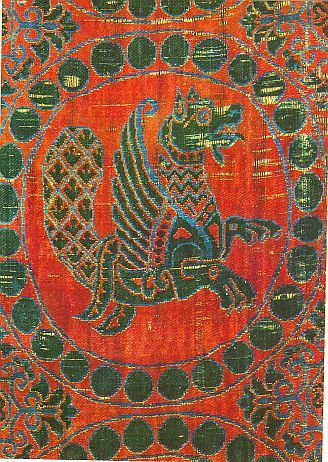
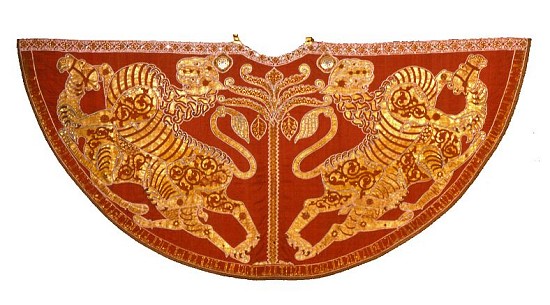
Now we begin to see things that are more familiar in the rug world.
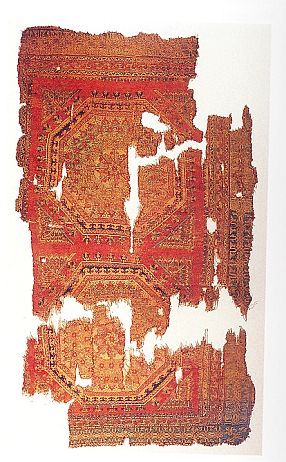
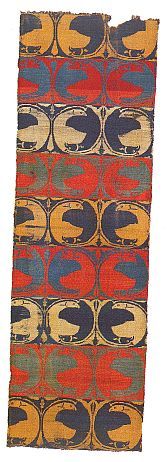
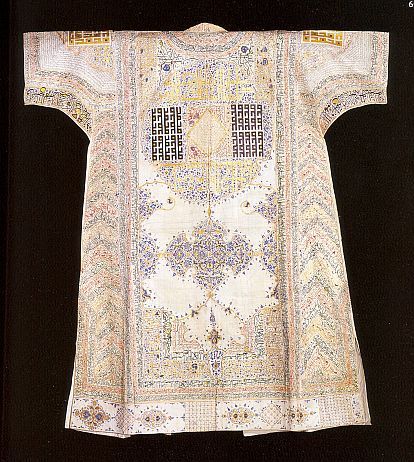
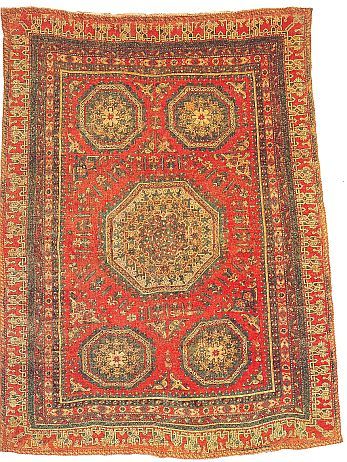
From the 15th century forward there are a lot more existing examples of rugs and textiles. The “Reds” exhibition includes items from various eras, so we, too, will skip through the remaining centuries with selected examples.
- 16th century. An Anatolian fragment
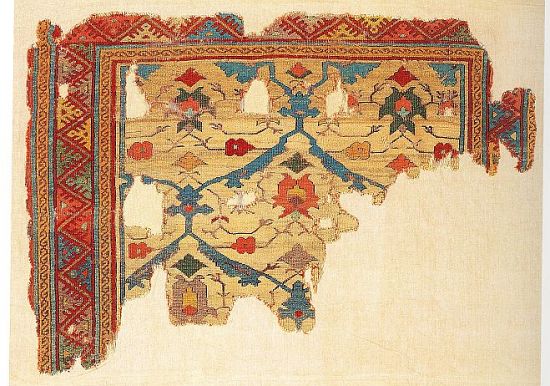
- A detail of a 17th or 18th century Kerman carpet
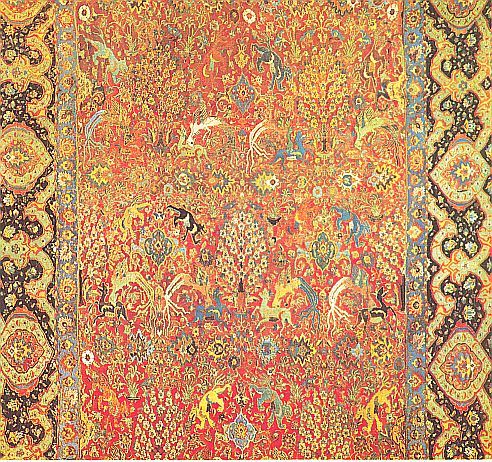
- an 18th century Ladik, with a niche field design
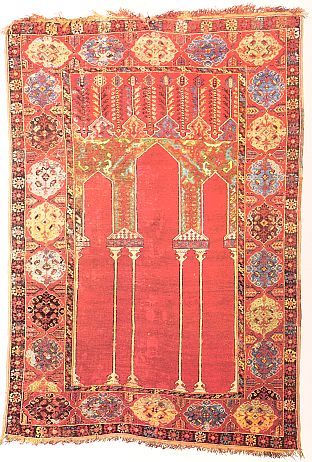
- A 19th century Tibetan door rug
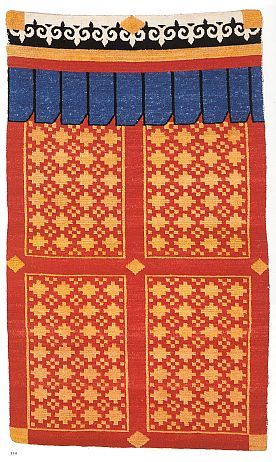
- A 19th century 3rd Phase Navajo Chief’s blanket,
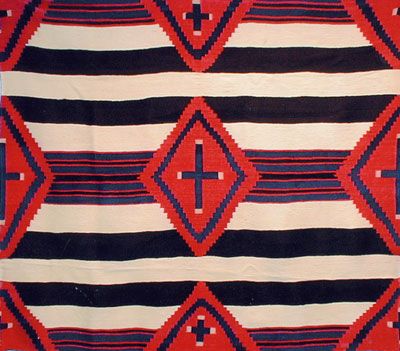
- and a 19th century woven carpet with Odd Fellows designs too strange not to include (The “Odd Fellows are a U.S. men’s social lodge) http://www.ioof.org/
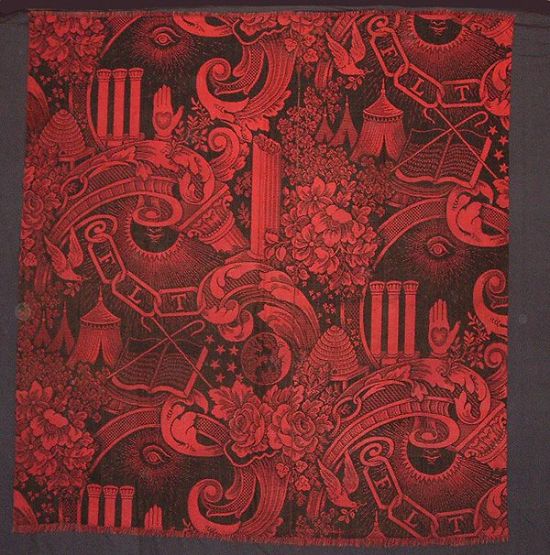
- 20th century: a Persian Zoroastrian woman’s costume

So that’s a very selective look at how red has been used in rugs and textiles over the centuries.

- Research such as that of Elizabeth Barber, two of whose books are listed below, currently suggests that textiles have been made as far back as 25,000 BC. The earliest technique is weft twining. Colors are harder to determine. There is lots of red ochre (a soil pigment, containing iron oxide) used deliberately in many excavation sites and sometimes to color textiles.
- Some textiles were found at Catal Huyuk (pronounced cha-tal-hoo-YUK) in Turkey (items from this site are dated at about 6,000 BC), but it is still debated whether they are wool or flax, much less whether they were dyed.
- Barber says the sources of dyes are known to have been plentiful early and there is sometimes evidence that they were collected, but proving that they were used to dye textiles is far more difficult.
- Barber also reports that the first real evidence of colored thread does come from the Catal Huyuk excavation. Melaart and his fellow researchers found a group of beads with traces of red inside their holes. The fact that there were no nearby sources of red has made researchers think that the beads were likely held together on a string colored with red.
- Despite the fact that it has been demonstrated that one can dye madder cold, without a mordant, iron derivatives function as mordants for various coloring agents. So the smelting of iron (something that first occurred about 1400 BC in the south-east Caspian Sea area) would seem to be an important dyeing marker date.
- 4000 BCE Nahal Mishmar in Israel - red woolen cloth, poss. green cloth
- 3000 BCE Adaouste in France - fragments dyed with kermes
- 3000 BCE Swiss Lake Dwellers - "Brocaded" linen tapestries must have had color to make woven areas distinct
- 2500 BCE Roswinkel in Holland - red woolen belt and net
- 2000 BCE Tell Quasileh in the Middle East - blue, white, and red fabric
- 2000 BCE Egypt - Many red, yellow, blue, green, brown, black linens
Barber has also published on some mummies found in far northwest China estimated to be from about 1,000 BC.

This mummy is over six feet tall, has brown hair, looks Caucasian and was labeled by the press, “Cherchen Man,” a reference to the name of a town near where the mummies were found.
Here is one observer’s description:
…It was the
outstretched body of
a man well over six feet tall, dressed in an elegantly tailored wool
tunic and matching pants, the color of red wine.

Covering the man's legs were striped felt leggings in riotous shades of yellow, red, and blue…
Barber was unable to get a sample to test to see if the red in this mummy’s garments are from madder.

Covering the man's legs were striped felt leggings in riotous shades of yellow, red, and blue…
Barber was unable to get a sample to test to see if the red in this mummy’s garments are from madder.

The Pazaryk rug, carbon dated to 500 BC has a complex, sophisticated design and a fairly wide array of colors, suggesting the product of a long tradition. The predominant one is its red ground.

Few, if any textiles survive from the Greek classical period. Literary accounts, as well as scenes from painted vases, make it clear that the ancient Greeks both wove textiles and made clothing. The principal material they worked with was wool, but linen from flax was also common.

In this same era we also have an example from South America.

This is described as an “Early Horizon” mantle estimated to have been woven 700-500 BC. The “Early Horizon” reference is to an early period of Andean cultural development.
A little closer look at a detail of it.

And about 500 years later, weavers in northwest China produced this skirt that is in a collection in Switzerland.

This fragment has been C-14 dated 123BC - 124AD and analyses of the dyes reveal that all of the red tones come from Indian madder, including the pink and the patch.
Some Roman textiles have survived, but, at least, until recently, most of the known Roman examples were from Egypt. Here is one small grouping.

“Roman” Egypt was followed in about 4 AD by “Coptic” Egypt for which we have quite a few surviving textiles.

And although there were rugs and textiles made all over the world during the next 900 or so years, until the 13th century, most of the currently known surviving examples (this may be changing) are from the Mediterranean area. Here are a few examples quickly just to let you see that red was not neglected during this relative hiatus in the historical textile record.
-
An Egyptian piece from the 6th century
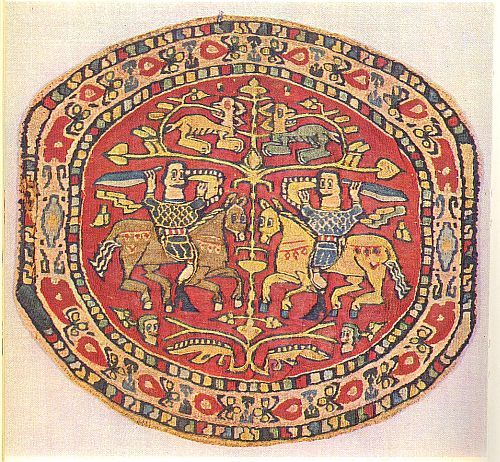

Here is another piece from pre-Columbian America. It is a Huari headband, about 600-800 AD.

-
A Syrian piece from the 8th
century

-
A Persian piece, estimated 10th century

-
A 10th or 11th
century clerical vestment, possibly from Italy

-
An 11th century textile from Spain

-
A
world-famous textile. A kermes-dyed mantle made in Palermo
for
the Norman King Roger II of Sicily in the 12th
century.

Now we begin to see things that are more familiar in the rug world.
- This is an Anatolian rug estimated to have been
woven in the 13th century.

-
This is a 13th-15th
century Indian textile of “silk samit.”
Samit is an
ancient structure: a weft-faced compound
twill.

-
A 15th century garment of a known
Ottoman sultan with a delicate use of red.

-
15th century rugs, usually
Anatolian, are quite frequent in
European paintings. 15th century
Persian rugs seem quite
rare. Here is a 15th century
“para-Mamluk” rug that
Walter Denny has argued is best seen as Persian and perhaps woven in
Tabriz.

From the 15th century forward there are a lot more existing examples of rugs and textiles. The “Reds” exhibition includes items from various eras, so we, too, will skip through the remaining centuries with selected examples.
- 16th century. An Anatolian fragment

- A detail of a 17th or 18th century Kerman carpet

- an 18th century Ladik, with a niche field design

- A 19th century Tibetan door rug

- A 19th century 3rd Phase Navajo Chief’s blanket,

- and a 19th century woven carpet with Odd Fellows designs too strange not to include (The “Odd Fellows are a U.S. men’s social lodge) http://www.ioof.org/

- 20th century: a Persian Zoroastrian woman’s costume

So that’s a very selective look at how red has been used in rugs and textiles over the centuries.